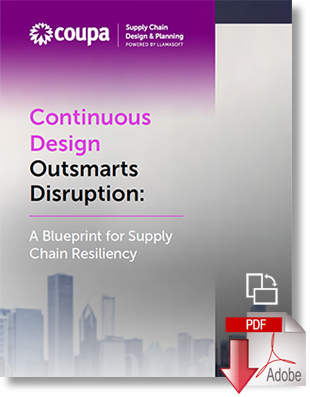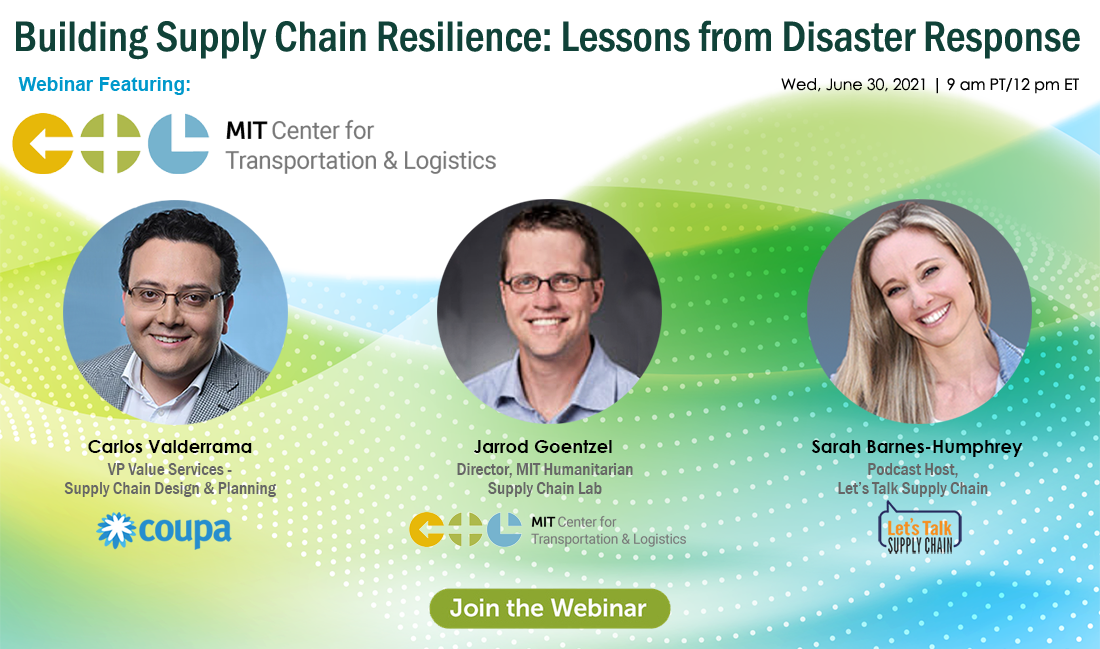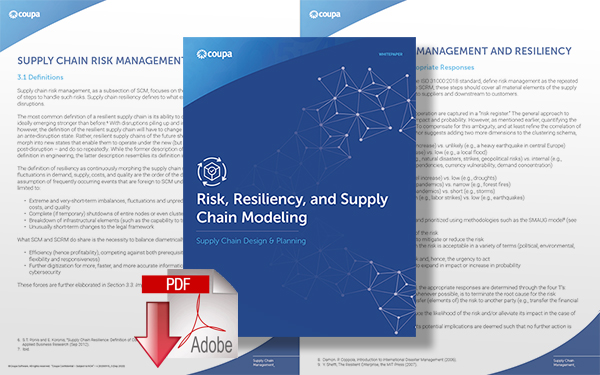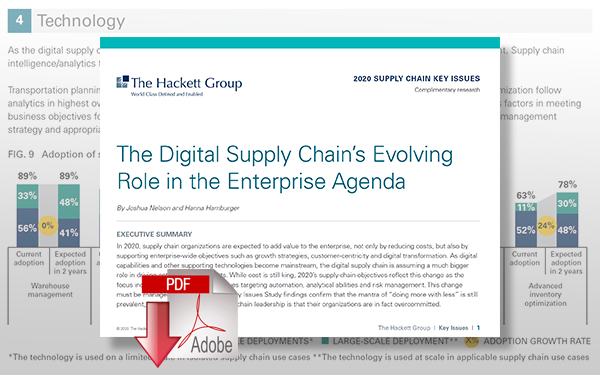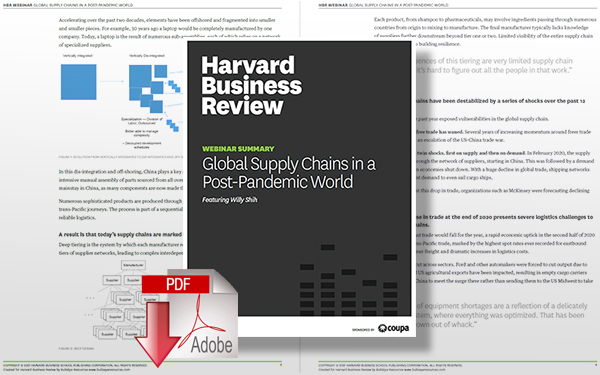Supporting Supply Chain Resiliency by Embracing the Principles of Continuous Design

While supply chain leaders have often prioritized factors such as visibility, cost, and speed, growing disruption in the past decade has led many to take a closer look at resiliency.
How Continuous Design Can Enhance Supply Chain Resiliency
Coupa recently hosted a webinar with Forrester about how continuous design can enhance supply chain resiliency.
As conditions continue to change, the ability to evolve operational and business models through continuous design will help organizations overcome the challenges of disruption.
A Growing Focus on Resilience
In recent years, the imperative for supply chain resilience has taken center stage at many organizations, said George Lawrie, Vice President, and Principal Analyst at Forrester. From trade wars and tariffs to natural disasters and the recent pandemic, growing uncertainty has led many decision-makers to put a greater focus on risk reduction.
In the face of the pandemic, many Forrester clients had alternative suppliers, materials, or routings, but lacked the ability to redesign systems to take advantage of them. For many, the most significant barrier was that their supply chain design was fixed based on an expectation of a similar level of demand and could not respond to the disruption.
“[A fixed network] gives you the lowest cost of distributing items, but what it doesn’t do, necessarily, is help you to manage uncertainty,” Lawrie said.
While many organizations have flexibility built into supply chains to adjust to common forecast areas or other outliers, other parameters can change at a rapid pace, Lawrie said. Global supply, ecommerce, and quick fulfillment have made supply chains more susceptible to shock and disruption.
Shortages of products like toilet paper, food items, and electronics in 2020 demonstrated that supply chain leaders could no longer rely on basic KPIs and data from traditional systems. “It changes the whole picture,” Lawrie said.
“Sometimes, they’re missing an opportunity because they are not thinking about the continuous design that drives for leading companies’ strategic benefit.”
The Ability to Adapt
Many companies are now tracking their supply chain effectiveness and adaptability compared to their peers, Lawrie said. They accomplish this by implementing a continuous design that enables them to adapt and balance “just-in-time” and “just-in-case” principles. By harnessing the capability to continuously redesign their supply chain and balance these concepts, they can maintain an economical supply chain that also guarantees resilience and availability to customers.
Lawrie said there are five steps to resilience and things people are doing to protect their supply chain:
- Design supply networks that are both efficient and resilient
- Assemble and employ a cross-functional supply chain risk team
- Simplify the supply chain
- Implement the right technology stack
- Build the right protection for each bottleneck
One of the main ways to attain greater resilience is to move beyond episodic planning from static networks, said Dr. Madhav Durbha, Vice President of Supply Chain at Coupa. Annual or bi-annual planning changes can no longer work in a frequently changing environment where supply chain leaders have to more regularly make complex decisions. Where to open new facilities, the cost to serve customers, and optimal stocking locations by customer segments will need to be revisited more frequently than in the past.
Organizations now need a design process that allows for end-to-end tradeoffs in a connected manner while offering visibility across the sources, manufacturing, and distribution. “Being able to connect these dots and be able to drive those tradeoffs. And also making supply chain policies that guide planning and execution far more dynamic are must-haves,” Durbha said.
Designing With a Digital Twin
Durbha proposes a sandbox environment where supply chain leaders can simulate a range of possibilities that address risk and resiliency within design processes to make the best planning decisions. The digital twin is a primary component of this continuous design process. It serves as a replica of the physical supply chain with all the nodes and flows, offering the ability to simulate decision outcomes in the digital environment.
“You can come up with predictions and models of the future and test out various policies,” Durbha said. “It offers the ability to render your entire supply chain with all of its complex interlinkages in a digital environment.”
Fortunately, supply chain leaders don’t need to rip and replace their capabilities to support such continuous design. As it simply informs decision-makers with better policies, they can often get more out of investments in planning and execution systems by prioritizing the capabilities that align with their business model.
For example, a retailer may use a digital twin to see what their micro fulfillment network should look like based on the location of their customers and expected delivery time. A company may also determine if they would have the ability to support a change in replenishment frequencies to downstream locations from four to five days per week.
“Embracing the principles of continuous design, you can test out different possibilities within the easy-to-train model, you can handle a lot of these complex questions that require end-to-end tradeoffs, in a very connected, frequent, and repetitive manner.”
OnDemand Webinar: Join Jarrod Goentzel (director of the MIT Humanitarian Supply Chain Lab at MIT CTL) for an interactive discussion on Building Supply Chain Resilience: Lessons from Disaster Response, moderated by Let’s Talk Supply Chain’s Sarah Barnes-Humphrey.
Building Supply Chain Resilience: Lessons from Disaster Response
Supply chains are constantly in the news with disruptions that cause global impact. In response, executive agendas now place supply chain resilience at the forefront to combat this ever-changing reality.
These supply chain experts will share:
- Lessons learned from disaster response efforts over the years, including ensuring continuity of essential supplies
- Stories about how the commercial sector dealt with recent disruptions
- Details of the importance of supply chain design in enabling resilience

Related Resources
Continuous Design Outsmarts Disruption: A Blueprint for Supply Chain Resiliency
In this ebook we discuss how continuous design can reduce risk, improve resilience, and turn supply chain challenges into a competitive advantage. Download Now!
Risk, Resiliency, and Supply Chain Modeling
This paper first examines why existing supply chain management practices do not naturally develop resilient supply chains and why some of the existing supply chain processes are not suitable for addressing such risks and required responses. Download Now!
Digital Supply Chain’s Evolving Role in the Enterprise Agenda
The Hackett Group 2020 Key Issues Study findings confirm that the mantra of “doing more with less” is still prevalent, but the top concern of supply chain leadership is that their organizations are in fact overcommitted, AI analytics to enable a more agile supply chain. Download Now!
Global Supply Chains in a Post-Pandemic World
In this webinar summary, Willy Shih, Robert and Jane Cizik Professor of Management Practice in Business Administration at Harvard Business School, shares insights into how global supply chains came to be the way they are and how their vulnerability has been revealed through numerous crises. Download Now!
More Resources from Coupa
Related Article: 2021 The Year for Companies to Build Supply Chain Resiliency
Article Topics
Coupa News & Resources
How Microsoft Improved ESG & Sustainable Spending Working Together with Community.ai Capabilities Supply Chain Agility in an Ever-Changing World How Sourcing Can Respond in Dynamic Markets to Drive Supply Chain Value Build Resilience in Supply Chains by Modeling & Designing Multiple Demand Futures Beyond Disruptions: Building the Next Generation of Resilient Supply Chains 6 Truths About Business Spend Management Technology 5 Ways Supply Chains Can Flourish in an Inflationary World More CoupaLatest in Supply Chain
Walmart Unleashes Autonomous Lift Trucks at Four High-Tech DCs Ranking the Best Countries for Private Business in EMEA Frictionless Videocast: The Importance of Water at the U.S./Mexico Border with Commissioner Maria-Elena Giner, International Boundary and Water Commission Why are Diesel Prices Climbing Back Over $4 a Gallon? Plastic Pollution is a Problem Many Companies are Still Ignoring Luxury Car Brands in Limbo After Chinese Company Violates Labor Laws 80% of Companies Still Unsure How to Best Leverage AI, Study Finds More Supply Chain

